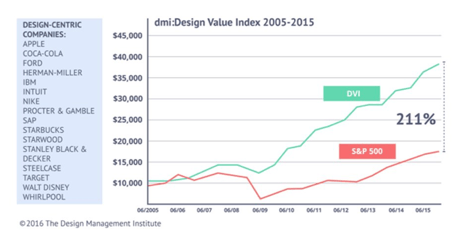While design thinking isn’t a new concept (it’s been around for almost 50 years), it's recently gained more traction as companies recognize its tremendous value.
Over the past 10 years, design-led companies have outperformed the S&P 500 by 211 percent.

This number tells us that businesses are becoming increasingly committed to centering their technology, products, and services around people.
So, what is design thinking? IDEO, a global design thinking company, defines the methodology as “a system that uses the designer's sensibility and methods to match people's needs with what is technologically feasible and what a viable business can convert into consumer value and market opportunity.”
More simply put, it is a process aimed at uncovering core business problems and finding solutions that work. How do we do this? By focusing on the end users – the ones who interact directly with the technology – and the entire process surrounding that technology. It is about discovering the art of the possible with the end users in mind.
Though there are a few variations to the design thinking process, most share an iterative theme. At ConvergentIS, we follow SAP’s five-step innovation process.

In the explore phase, we work closely with the stakeholders to explore what areas require innovation.
Once we’ve determined an area of focus, and in order to get an accurate understanding of the problems we are trying to solve, we work closely with the business, either with the end user or with users in customer-facing roles. Working collaboratively helps organizations shed their orthodoxies and discover new possibilities. During workshops, the expert facilitator helps collect and organize the information coherently for review and assessment.
Once we’ve identified their core problems, we begin ideating solutions together. This typically takes the form of a ‘whiteboard session’, where we invite customers into our SAP AppHaus Design Centre and arm them with coloured Sharpie markers and Post-it notes. Tools in hand, we begin brainstorming ideas based on prompts from our Design Thinking experts.
The next step is to develop prototypes, which often start out as simple paper mock-ups. Low-fidelity prototypes are more practical for users to test out the solutions and make impromptu changes; they are more likely to commit to an idea that’s been digitally rendered, even if it’s not the most effective solution.
Early and accurate user testing is a critical part of design thinking and it’s important that users can identify potential roadblocks early on.
Once feedback is received on the paper prototypes, the process loops back – prototypes continue to be refined and tested until the best solution is determined.
Its in the delivery phase where the prototypes truly come to life and development starts after much user testing and sign-off from the business.
5. RUN & SCALE
Here the solution is deployed and users get their hands on the finished product and all the benefits from a tried and tested application.
Design thinking is a front-end loaded process. The power lies in understanding the people who will be using the technology and how it helps them accomplish their goals and from there, prototyping and testing with the end user until a refined idea is developed. Sometimes the process involves completely starting over! But this iterative process ultimately helps achieve a highly usable – and widely adopted – solution.
The up-front investment is also proven to save significant amounts of time and money on the overall project. When a project leverages design thinking, every dollar spent results in a return on investment of up to $100.
And perhaps most importantly, it also leads to happier customers who can now enjoy technology that is role-based, responsive, simple, coherent, and delightful.
This post is the first in our Design Thinking in Practice series. Read the next phase.
Or, download our full guide using the form below.


